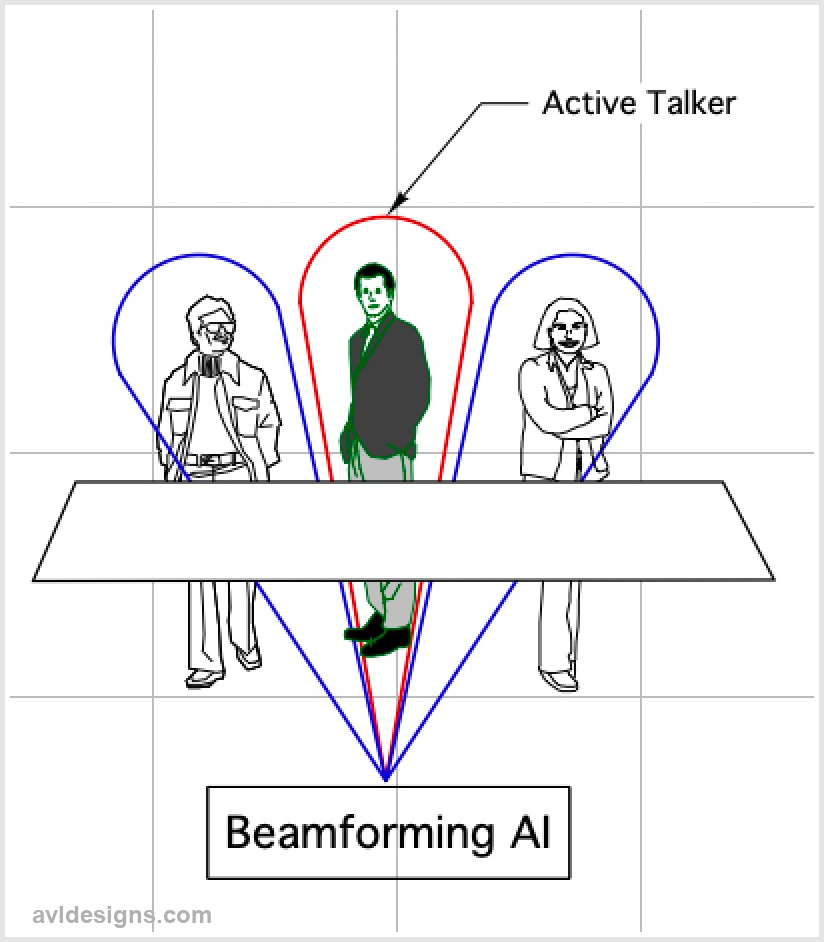Picking up a large area with distant microphones naturally adds in the room sound (resonance) as well. Those who are in the room most likely think it sounds fine. Our brains process sound in a very sophisticated manner using both ears. But that is not how microphones work.

The way a mic works compared to how our ears work can make a video conference sound like a subway tunnel when the sound in the entire room is picked up. Solutions to the problem are abundant. Sorry to say, though, that none of them are inexpensive. The better solutions involve audio intelligence in the mics.
Good – Better – BEST!
So, you have a couple of choices when you get down to the idea of “good, better and best” in a room. If you want good audience participation without spending a lot of money, the users must be involved. If you want your video conferencing setup to be “plug and play,” then it isn’t going to be cheap.
Any mic used close– headset or handheld – primarily picks up the voice of the person speaking with little of the room sound added in. When distant mikes designed for conference rooms are used, they do not do well in larger spaces.. If the space has sound reinforcement, it is an even bigger problem. Unless you get a mike with AI (artificial intelligence) and DSP (Digital Signal Processing.)
LOW END SOLUTION
AUDIENCE Mics On Stands
- Place handheld wireless microphones on mic stands in a few locations out in the room, gain structured to match what the presenter’s mic is doing. The audience mic is then automated so that it only activates when some gets close to it and is talking. Anyone with a question must walk up to a microphone. This system works reliably and is relatively simple.
PROS and CONS
- Sounds Good. Doesn’t t pick up random noises like coughing, etc.
- Works with sound reinforcement used in the room.
- On the negative side, people must get up to talk.
HIGH END SOLUTION
NARROW BEAM, AUTO Steered array Mics – WITH Built-in Intelligence
All beam-formed microphones use an AI algorithm to decide who is talking. If everyone in the room is polite, this works well — kind of like a zoom call where everyone has learned to wait their turn. If too many people talk at once, even this AI solution will have some issues as the mics track to whatever sound is loudest at the moment.
Many beam-formed mics pick up too large a section of the room at once, making the room sound hollow. Some use narrow tracking beams that move, so that only a small amount of room energy is picked up and a maximum amount of the person they are supposed to pick up.
This type of solution can have limitations when you want to use loudspeakers within the room to amplify the presenter. You may run into problems in some spaces that are too large for the presenter to be heard without sound reinforcement. This is where a DSP and a presenter mike must also be included.
PROS and CONS
- Pros
- The entire room can be picked up
- Can be used with sound reinforcement with the additions of DSP.
- Can sound pretty good and pick up an entire room
- Cons
- Cost – Mic plus DSP (digital sound processor) can be $$$ (Solutions that work well cost in the range of $ 15.00/sq ft covered or higher. (About $18 K for a 40 X 30 ft room).
- If a room is small enough that it does not need sound reinforcement, the DSP could be dropped.
- The entire room is picked up – no control over who can or cannot talk.
- Cost – Note* some mike solutions do not work with sound reinforcement for the presenter being used.
- Mics automatically catch sounds. So, someone coughing etc…. becomes an active sound source.
Other alternatives that can be utilized involve operator interfaces. Say, for instance, you have a control touch screen in the room and a presenter is speaking on their microphone. When they want the audience to say something, they would have to press a button for audience response. Pressing that button turns off the presenter’s mic and turns on the audience mic.
The audience mic would have a series of DSP tuning filters, which is another piece of hardware added to the system which will help with the reverberation and the sound quality of a more general pickup microphone. This would have to be selected by the person using the room. And if they forget to de-select it, then the microphone they are wearing will no longer be active. That is where you end up with a hollow sound in the background, picking up the whole room the whole time while the presenter’s mic is off.
Properly tuned a high-end system sounds like there is a sound man mixing the audio in the room, to the far side of the conference.
Copyright AVLDESIGNSInc 2021+
